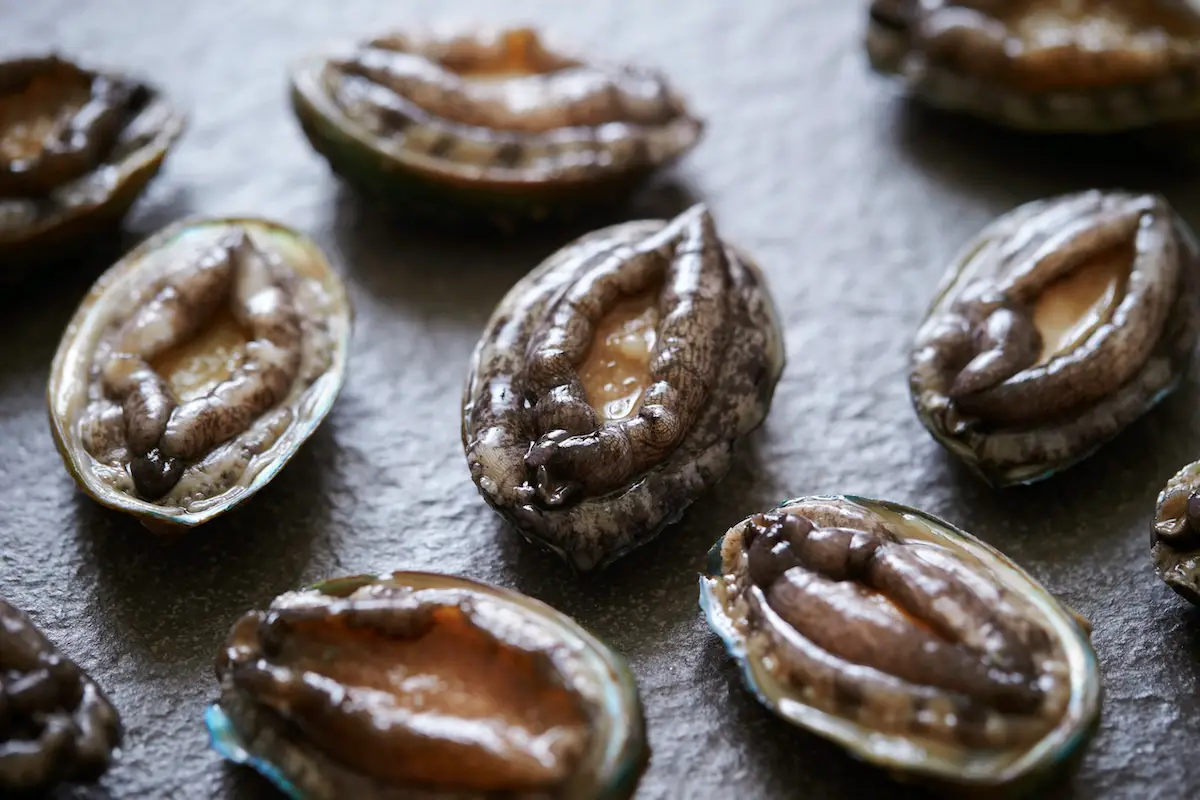This post may contain affiliate links. Please read my disclosure for details at the bottom of this page. As an Amazon Associate, I earn from qualifying purchases on this article about abalone in Korean cooking. I hope you enjoy learning about abalone, otherwise known as jeonbok!
What Is Abalone (Jeonbok)?
Abalone, otherwise known as ‘jeonbok’ (전복) in the Korean language, is a marine gastropod mollusk in the family Haliotidae. Also commonly known as ear shells or sea ears, these large sea snails are common in coastal salt waters throughout much of the world. You can find them in the waters of New Zealand, Australia, South Africa, South Korea, Japan, and the West Coast region of North America.
At this time, there are approximately 50 known species!
Besides the flavor, jeonbok is famous for its beautiful shells which are composed of nacre, otherwise known as mother-of-pearl. These strong shells are used to make decorative objects, furniture, and jewelry.
Abalone in Korean Cuisine:
As stated above, in South Korea, people refer to to this sea snail as ‘jeonbok’ (전복). Below, I list a few well-known dishes that often include this ingredient:
- Jeonbokjuk (전복죽): Korean abalone rice porridge. This is commonly considered the ‘king of porridge’ in Korea.
- Jeonbok Hoe (전복회): Korean-style raw and sliced abalone
- Jeonbok Gui (전복구이): Grilled or roasted abalone
- Jeonbok Sotbap (전복 솥밥): In English, we translate this to ‘abalone pot rice.’ ‘Sotbap’ is a style of Korean cooking in which you cook rice in a pot topped with other ingredients to add flavor. In this case, you use abalone!
In South Korea, people covet this expensive product for the delicious flavor and beautiful shells.

Abalone (Jeonbok) Frequently Asked Questions:
Now that we learned about jeonbok in Korean cuisine, I want to answer some questions you may have about this ingredient! If I do not answer your question, feel free to leave a comment in the section below or email me at [email protected].
What Does Abalone Taste Like?
Abalone tastes rich and sweet with a deliciously salty and buttery finish.
This ocean mollusk has a chewy texture much like calamari. When cooked properly, the chewiness is soft and satisfying. When cooked improperly, the it gains a rubbery texture rendering it almost impossible to chew through.
Can I Buy Fresh Abalone In the United States?
As I stated above, abalone is a rare and expensive ingredient around the world as well as in the United States. While native to the coastal waters of California, Oregon, and Washington, the United States has a fishing ban on certain native species of this ingredient.
Though certain species of abalone are common and abundant elsewhere in the world, the green, pink, and white species native to the West Coast of the United States are classified as engaged because of their staggeringly low populations. This endangered classification is enough to compel a fishing ban.
Where Can I Buy This Ingredient?
Excitingly, you can buy different fresh, frozen, and/or canned abalone species from areas other than the West Coast of the United States! You can buy farmed varieties from the US as well!
I recommend checking for fresh or frozen jeonbok at your local Asian grocery store. You can also buy fresh abalone online to be delivered to your door (during the abalone fishing season). Just note that abalone can be difficult to buy even with these resources.
How Do I Properly Store Jeonbok?
You should store abalone differently based on the type you bought:
- First, you should keep canned abalone in the pantry until it expires. Before use, drain the can and rinse the product.
- You should store frozen store-bought abalone in the freeze. When you desire to cook with this product, slowly thaw the seafood at room temperature or in the refrigerator in an airtight container.
- Finally, keep fresh abalone in the refrigerator and use it as soon as possible. I recommend using fresh abalone the day you buy it or have it delivered!
What Is a Jeonbok Substitute?
Traditionally, people use conch as a substitute for abalone. The commercial fishing industry often label conch as ‘mock abalone’ because of its similar taste and texture.
Note: Unfortunately, you cannot count on using the famous ‘queen conch’ because, as of September 2022, a proposal was submitted to add the queen conch to the list of threatened species.
If you cannot find sustainably sourced conches, you can use ingredients such as scallops, mussels, and clams instead. While not a great substitute, these options add the salty, buttery flavors of the sea.
I Hope You Enjoyed Learning About Abalone (Jeonbok)!
In the end, I hope you enjoyed learning about the uses of abalone in Korean cuisine. If so, let me know in the comment section!
If you would like to read more about cooking, you can find recipes as well as further Korean ingredient articles on my blog. I listed some of our favorite Carving A Journey Korean recipes below! For reference, many recipes are influenced by my family’s blended Korean and Southern heritage.
Korean Ingredient Articles:
- Hot Mustard in Korean Cooking (Gyeoja)
- Korean Fish Cake (Eomuk or Odeng)
- Dried Anchovies (Myeolchi)
- Nuruk (Traditional Korean Starter Culture); And
- Korean Green Plum Extract (Maesil Cheong)
Further Carving A Journey Recipes:
If you have any questions or comments, you can also email me at [email protected]. And, finally, I would love to hear from you through social media as well! You can follow me at @carvingajourney on Instagram, Facebook, and Pinterest. I also started a vlog Youtube channel! Or, if you would like more articles like these, you can subscribe to my blog by joining the mailing list. Let me know if you try cooking with jeonbok! Thank you so much for stopping by!
Carving A Journey is a participant in the Amazon Services LLC Associates Program, an affiliate advertising program designed to provide a means for sites to earn advertising fees by advertising and linking to Amazon.com. Although we may earn commissions for our endorsement, recommendation, testimonial, and/or link to any products or services from this website, these opinions are my own and I fully support these products.

